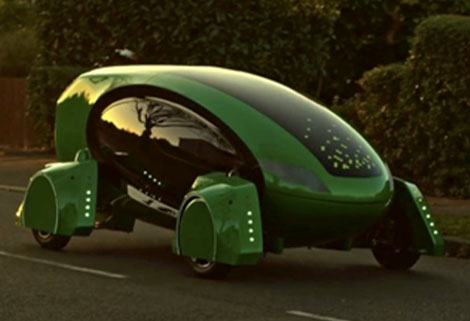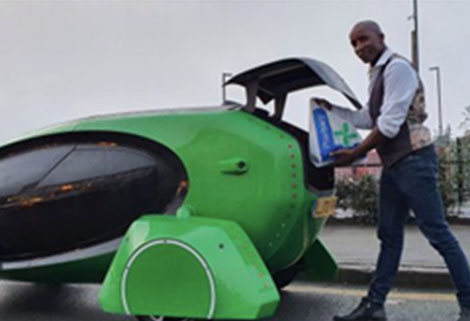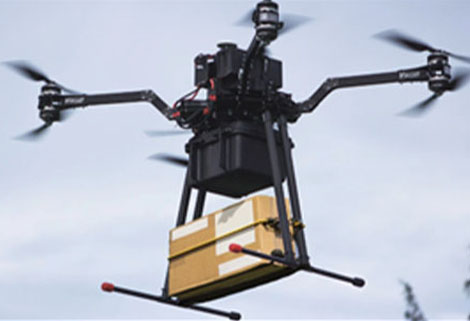fi's fabulous floating emporium...
magic created inside the boat for fun on the outside
 One of the most colourful characters on the cut is Fiona Lewis, who lives and trades from her narrowboat Calabrese. She is a registered roving trader, with her business very aptly named "Fi's Fabulous Floating Emporium". Fi is currently based on the Gloucester & Sharpness Canal.
One of the most colourful characters on the cut is Fiona Lewis, who lives and trades from her narrowboat Calabrese. She is a registered roving trader, with her business very aptly named "Fi's Fabulous Floating Emporium". Fi is currently based on the Gloucester & Sharpness Canal.
For the past twenty years, Fi has been a self employed Festival / Event Trader, making most of her own stock. She moved onto a boat in 2017, and found it was fairly easy to transfer her creative skills onto the water.
Because of the restrictions currently imposed upon our society, Fi is concentrating upon her online sales, but she is hoping to expand 'Fi's Fabulous Floating Emporium' and also open a floating tuck shop, with hot snacks, 'yummy cakes' and organic squash.
early days...
 Fi, herself a mother, comes from 'a beautiful large family with lots of lovely nieces and nephews'. In fact, at the last count, she has 19 great nieces and nephews!
Fi, herself a mother, comes from 'a beautiful large family with lots of lovely nieces and nephews'. In fact, at the last count, she has 19 great nieces and nephews!
She believes she always had a creative streak - probably inherited from her Granny Hedwig. Growing up, she was continually making things from cardboard, fabric or twigs.
When all the girls in the family wanted parties and hair-braids and face-painting were in high demand, one of them (that's Fi and her three sisters) had to learn the necessary skills.
Of course it fell to Fi! She remembers her very first hair braid which took almost an hour to perfect...
Anyway, she got faster, and before long she found herself running her own children's party business.
moving on...
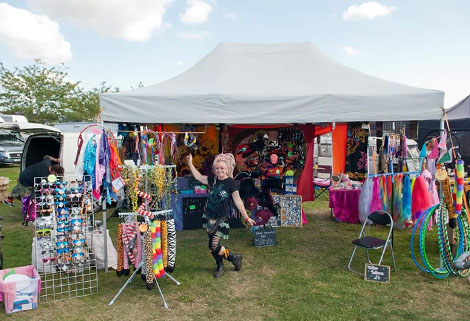
Fi continued to do well with her party business but it wasn't enough to keep her occupied - she needed something more.
Eventually she decided to create her own stall for selling goods at festivals and other field events.
This meant that as well as the face-painting and braiding, she could now also sell a range of festival clothing and other goods.
This went well for a while, but Fi soon began to realise that many festival stalls ended up selling much the same sorts of goods. She decided she needed something unique so that her stall could stand out from the rest. So Fi began making some of her own stock.
Hats were one of the first things she began to make. They proved so popular, that 15 years later she is still creating them. Understandably, as they are all unique, and as funky as you want them to be. Needless to say, they are among her best selling items!



At the same time, she turned some of her attention to Hula Hoops.
Fi is a qualified Hula Hoop coach and teaches hula hooping. She has taught both children and adults at festivals and, more recently, along the towpath! It's not an uncommon sight to see Fi hula hooping on the roof of her boat...

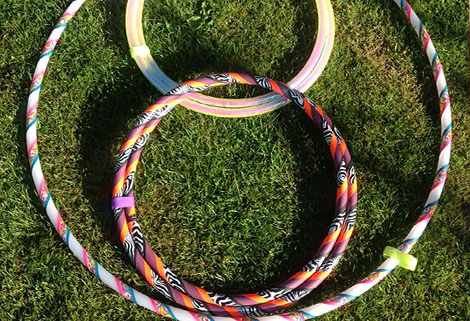
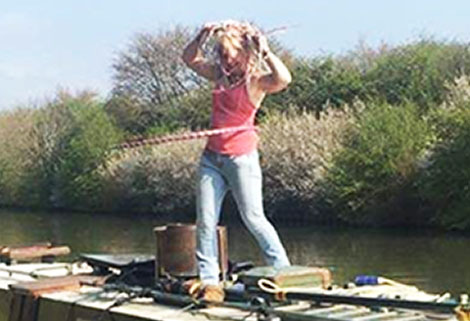
goods on offer...

hand made hats from Fi's own designs
hair accessories - dreads, hair bands, braids
bags - sourced from India and Fair Trade
fair trade items - from homewares to clothing (from recent trips to India)
festival clothing and accessories
bandanas for dogs
hula hoops in different sizes



covid restrictions and trading
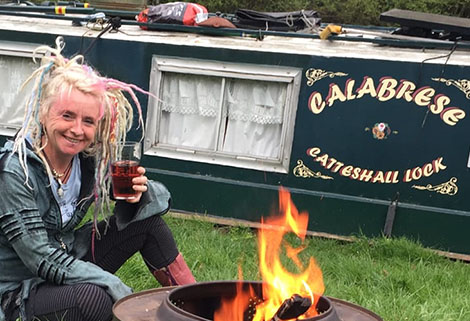 2020 was almost a write-off for trade, affecting traders on and off the water.
2020 was almost a write-off for trade, affecting traders on and off the water.
But it was a year in which Fi managed to enjoy her floating home and get some home improvements done too!
She says:
"I love my life on the water and the people I surround myself with. I like meeting great characters with great stories to tell."
 Fi's Fabulous Floating Emporium is currently based on the Gloucester and Sharpness Canal.
Fi's Fabulous Floating Emporium is currently based on the Gloucester and Sharpness Canal.
You can follow Fi on Facebook to see where she is trading, or you can buy from her online.
You can also contact Fi by email
And if you do come across her on the towpath, do stop for a chat. She might even show you how to hula hoop!

 Paul Buga had previously been on hunger strike for more than two weeks outside Downing Street in an attempt to get his boat back from CRT. Alerted to concerns for his wellbeing, the NBTA stepped in to support him and to find him a solicitor.
Paul Buga had previously been on hunger strike for more than two weeks outside Downing Street in an attempt to get his boat back from CRT. Alerted to concerns for his wellbeing, the NBTA stepped in to support him and to find him a solicitor.

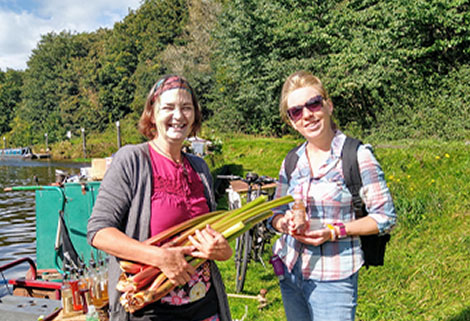 I now live and work on a travelling narrowboat business. I began as ‘Cake on the Cut’ making homemade cakes, hence my Salted Caramel Gin. But I have slowly evolved into ‘Gangplank Spirits & Preserves' and I make foraged fruit gin, whisky, rum, vodka, chutney, jam & cordial. I also open as a café selling soft drinks and crepes, and I have a fully licenced bar.
I now live and work on a travelling narrowboat business. I began as ‘Cake on the Cut’ making homemade cakes, hence my Salted Caramel Gin. But I have slowly evolved into ‘Gangplank Spirits & Preserves' and I make foraged fruit gin, whisky, rum, vodka, chutney, jam & cordial. I also open as a café selling soft drinks and crepes, and I have a fully licenced bar. I’ve been boating 15 years now and I’m still very in love with the lifestyle. The towpath is a friendly place where people like to talk to each other and help each other out. Most boaters are unmaterialistic and happy with the simple things in life, a fire, good company, a stew in the pot, and a pint.
I’ve been boating 15 years now and I’m still very in love with the lifestyle. The towpath is a friendly place where people like to talk to each other and help each other out. Most boaters are unmaterialistic and happy with the simple things in life, a fire, good company, a stew in the pot, and a pint.
 The everyday small adventures are just as fun, all the windy rainy days, being blown across the cut, fallen trees blocking the canal, single handing swing bridges that open on the wrong side, going down the weed hatch for the third time in a day...
The everyday small adventures are just as fun, all the windy rainy days, being blown across the cut, fallen trees blocking the canal, single handing swing bridges that open on the wrong side, going down the weed hatch for the third time in a day...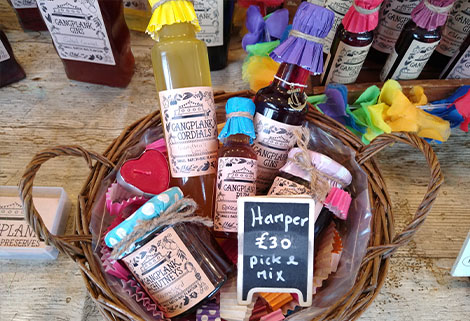 This year has been one of the most difficult I’ve ever had on the cut. I had to have a complete re-plate of my boat during lockdown and borrow the money in one of the most financially challenging years for my business.
This year has been one of the most difficult I’ve ever had on the cut. I had to have a complete re-plate of my boat during lockdown and borrow the money in one of the most financially challenging years for my business. Fortunately this has been more than compensated for by the number of super generous people who have gone out of their way to support me and my small business, and realising more than ever what fantastic friends and family I’m lucky enough to have.
Fortunately this has been more than compensated for by the number of super generous people who have gone out of their way to support me and my small business, and realising more than ever what fantastic friends and family I’m lucky enough to have. The public have been incredible, people have really been trying to support the small business owner for which I am immensely thankful. They have literally kept me afloat.
The public have been incredible, people have really been trying to support the small business owner for which I am immensely thankful. They have literally kept me afloat.